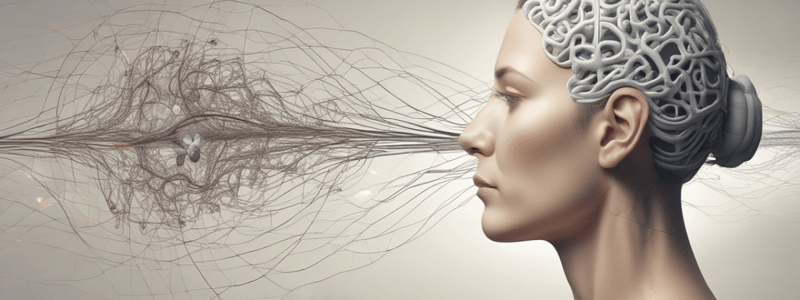Podcast
Questions and Answers
What is the primary purpose of SSEP stimulation during a rehab visit?
What is the primary purpose of SSEP stimulation during a rehab visit?
- To increase patients pain tolerance
- To decrease heart rate
- To precharge the brain and fire into certain areas of the brain (correct)
- To heal neuropathy
Which of the following is NOT involved in the rehabilitation (One System) phase of a rehab visit?
Which of the following is NOT involved in the rehabilitation (One System) phase of a rehab visit?
- Repositioning Maneuver
- Visual/Vestibular Rehab
- Complex Movements
- NSI (correct)
Which system integrates two or more systems during a rehab visit?
Which system integrates two or more systems during a rehab visit?
- SSEP
- Gammacore
- Gaze stability
- Proactive on NSI (correct)
What nerve does the Gammacore stim?
What nerve does the Gammacore stim?
Does it matter if the doctor or the rehab sees the patient first?
Does it matter if the doctor or the rehab sees the patient first?
What are the vielight options?
What are the vielight options?
How long should a maneuver be practiced before transitioning to a new therapy?
How long should a maneuver be practiced before transitioning to a new therapy?
Which of the following therapies is focused on working with one system only?
Which of the following therapies is focused on working with one system only?
What does the integration phase of rehab typically involve?
What does the integration phase of rehab typically involve?
Which of the following is a technique used to calm down the nervous system during a rehab visit?
Which of the following is a technique used to calm down the nervous system during a rehab visit?
What is the proper flow of the rehab visit?
What is the proper flow of the rehab visit?
Which of the following does NOT involve working on multiple systems during rehabilitation?
Which of the following does NOT involve working on multiple systems during rehabilitation?
Why do we use the Alpha setting?
Why do we use the Alpha setting?
When you are finished with your patient and they are seeing the doctor next you should?
When you are finished with your patient and they are seeing the doctor next you should?
Why do we want patients relaxed and calm during a session?
Why do we want patients relaxed and calm during a session?
What does the setting Gamma do?
What does the setting Gamma do?
Flashcards are hidden until you start studying
Study Notes
Flow of a Rehab Visit
- Begins with stimulation to energize and prepare the brain, akin to stretching before physical activity.
- Stimulation can also calm the nervous system, promoting relaxation and readiness for rehabilitation.
Stimulation Techniques
- SSEP (Somatosensory Evoked Potentials): A test that measures the brain's response to sensory stimuli, indicating nerve function.
- Gammacore: A non-invasive nerve stimulation device that targets the vagus nerve, potentially aiding in various conditions.
- Vielight: Utilizes light therapy to enhance brain function and promote healing processes.
Rehabilitation Focus
- Centers around addressing one specific system at a time.
- Repositioning Maneuver: Techniques to alter body position to alleviate symptoms or improve function.
- Complex Movements: Exercises designed to develop coordination and integration of various bodily systems.
- Visual/Vestibular Rehab: Aims to improve balance and spatial orientation through targeted therapies.
Integration Techniques
- Involves working on two or more systems simultaneously to enhance overall recovery.
- NSI (Neurological Stimulus Integration): A method that integrates neurological stimuli to improve responsiveness and function.
- Balance on NSI: Focuses on achieving stability through integrated neurological stimuli, crucial for improving balance and coordination.
Flow of a Rehab Visit
- Stimulation phase prepares the brain, akin to stretching before physical activity.
- This phase can either energize the brain or soothe the nervous system.
- Techniques include SSEP (Somatosensory Evoked Potential), Gammacore, and Vielight.
Rehabilitation Focus
- Aims at improving one specific system during therapy.
- Involves repositioning maneuvers to correct alignment and support function.
- Emphasizes complex movements to enhance mobility and coordination.
- Incorporates visual and vestibular rehabilitation to address balance and spatial orientation issues.
Integration Phase
- Targets the interaction of two or more systems for comprehensive healing.
- Uses NSI (Neurosensory Integration) techniques to facilitate system connectivity.
- Balance exercises on NSI are crucial for enhancing overall stability and coordination.
Therapy Progression
- Each maneuver is typically practiced across three visits.
- After three visits, introduce a new therapy to maintain progress and adapt to recovery needs.
Warming Up/Charging the System
- Warming up is crucial for preparing the body, akin to stretching before physical activity.
- SSEP (Somatosensory Evoked Potential): Measures electrical activity in the brain in response to sensory stimulation, used for assessing neural pathways.
- Gammacore: A device that delivers non-invasive vagus nerve stimulation to help manage various conditions including migraines.
Energy/Healing
- The brain requires adequate resources for effective change and healing.
- Vielight: Utilizes low-level laser therapy to enhance cognitive function and brain healing.
- Red Light Mat: Employs red and near-infrared light for healing and recovery, promoting cellular energy production.
- Hydrogen Gas: Known for its antioxidant properties that may help reduce inflammation and improve metabolic processes.
- HBOT (Hyperbaric Oxygen Therapy): Involves breathing pure oxygen in a pressurized room, aiding in tissue repair and recovery from various conditions.
- PEMF (Pulsed Electromagnetic Field Therapy): Uses electromagnetic fields to promote healing at cellular levels.
- Gladiator: Likely refers to a specific therapeutic device or system designed to enhance physical performance and recovery.
Rehabilitation
- Focused rehabilitation targets individual systems for recovery and improvement.
- Proprioception: Essential for balance and body awareness; training may involve:
- Cervical Proprioception/Decoupling: Techniques or devices such as a halo that help improve neck proprioceptive feedback.
- Core Stability: Training aimed at strengthening core muscles to enhance overall stability and posture.
- Visual/Vestibular Rehab: Techniques designed to improve vision and balance, including:
- Repositioning Maneuvers: Movements aimed at correcting vestibular disorders affecting balance.
- Gaze Stability: Exercises to enhance the ability to maintain visual focus during head movements.
Integration
- Integration therapies work across multiple systems to promote holistic recovery.
- NSI (Neurostructural Integration): A therapeutic approach focusing on improving neurobiological function and structural integrity.
- Tilt Table Therapy: Used for assessing and improving the body's response to changes in posture, beneficial for patients with balance and vestibular issues.
Warming Up/Charging the System
- Warming up is crucial for preparing the body, akin to stretching before physical activity.
- SSEP (Somatosensory Evoked Potential): Measures electrical activity in the brain in response to sensory stimulation, used for assessing neural pathways.
- Gammacore: A device that delivers non-invasive vagus nerve stimulation to help manage various conditions including migraines.
Energy/Healing
- The brain requires adequate resources for effective change and healing.
- Vielight: Utilizes low-level laser therapy to enhance cognitive function and brain healing.
- Red Light Mat: Employs red and near-infrared light for healing and recovery, promoting cellular energy production.
- Hydrogen Gas: Known for its antioxidant properties that may help reduce inflammation and improve metabolic processes.
- HBOT (Hyperbaric Oxygen Therapy): Involves breathing pure oxygen in a pressurized room, aiding in tissue repair and recovery from various conditions.
- PEMF (Pulsed Electromagnetic Field Therapy): Uses electromagnetic fields to promote healing at cellular levels.
- Gladiator: Likely refers to a specific therapeutic device or system designed to enhance physical performance and recovery.
Rehabilitation
- Focused rehabilitation targets individual systems for recovery and improvement.
- Proprioception: Essential for balance and body awareness; training may involve:
- Cervical Proprioception/Decoupling: Techniques or devices such as a halo that help improve neck proprioceptive feedback.
- Core Stability: Training aimed at strengthening core muscles to enhance overall stability and posture.
- Visual/Vestibular Rehab: Techniques designed to improve vision and balance, including:
- Repositioning Maneuvers: Movements aimed at correcting vestibular disorders affecting balance.
- Gaze Stability: Exercises to enhance the ability to maintain visual focus during head movements.
Integration
- Integration therapies work across multiple systems to promote holistic recovery.
- NSI (Neurostructural Integration): A therapeutic approach focusing on improving neurobiological function and structural integrity.
- Tilt Table Therapy: Used for assessing and improving the body's response to changes in posture, beneficial for patients with balance and vestibular issues.
Studying That Suits You
Use AI to generate personalized quizzes and flashcards to suit your learning preferences.




